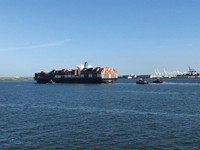Advertisement
Grab your lab coat. Let's get started
Welcome!
Welcome!
Create an account below to get 6 C&EN articles per month, receive newsletters and more - all free.
It seems this is your first time logging in online. Please enter the following information to continue.
As an ACS member you automatically get access to this site. All we need is few more details to create your reading experience.
Not you? Sign in with a different account.
Not you? Sign in with a different account.
ERROR 1
ERROR 1
ERROR 2
ERROR 2
ERROR 2
ERROR 2
ERROR 2
Password and Confirm password must match.
If you have an ACS member number, please enter it here so we can link this account to your membership. (optional)
ERROR 2
ACS values your privacy. By submitting your information, you are gaining access to C&EN and subscribing to our weekly newsletter. We use the information you provide to make your reading experience better, and we will never sell your data to third party members.
Trade
U.S. readies tariffs on $200 billion worth of Chinese imports
Many chemicals are affected, but rare earths are excluded
by Jean-François Tremblay
September 18, 2018

Following public hearings last month, the administration of U.S. President Donald Trump says it is moving ahead with tariffs on $200 billion worth of Chinese goods. A 10% tariff on a finalized list of goods will go into effect on Sept. 24; should China and the U.S. fail to reach a trade deal this fall, the rate will rise to 25% on Jan. 1, 2019.
Initial prospects for such a deal look dim. On Tuesday, Sept. 18, a day after the U.S. decision, China announced its own import tariffs of 5% and 10% on $60 billion worth of U.S.-made goods, also to go into effect on Sept. 24.
The dueling tariffs are an escalation of a trade conflict that President Trump started in the spring to pressure China to change business and trade policies, such as forced technology transfers to Chinese companies. In the summer, the U.S. Trade Representative, which manages U.S. international trade policy, began collecting a 25% tariff on $50 billion worth of Chinese imports.
“These practices plainly constitute a grave threat to the long-term health and prosperity of the United States economy,” President Trump said at the time.
The products on the $200 billion list include a large number of chemicals that China exports widely such as sodium cyanide, used in gold mining, and the polyurethane component methylene diphenyl diisocyanate.
The U.S. Trade Representative decided to exclude from its final schedule some materials, including ones like rare earths that are available almost exclusively from China. According to the American Chemistry Council (ACC), the U.S. chemical industry’s main trade group, 142 chemicals and plastics were removed from the final list, but it still includes 1,363 chemicals.
“There is no acceptable tariff rate for global chemicals trade with China or any U.S. trading partner,” ACC CEO Cal Dooley said in a statement issued after the finalized list of custom duties was announced. “Tariffs and quotas unnecessarily raise costs, deter innovation and economic growth, and could ultimately weaken our country’s competitive advantage.”



Join the conversation
Contact the reporter
Submit a Letter to the Editor for publication
Engage with us on Twitter